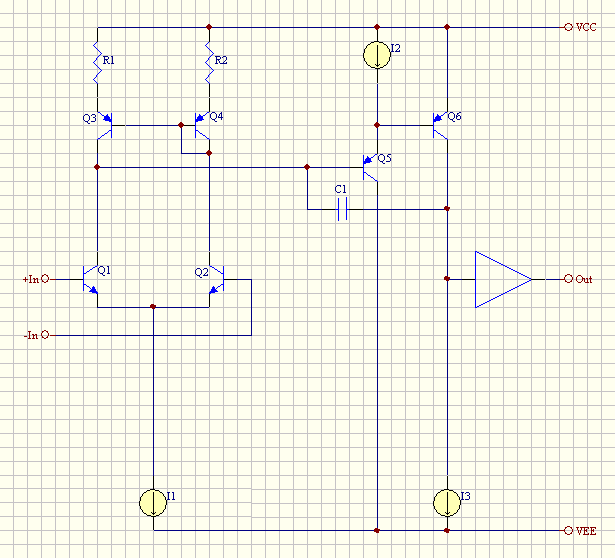Samuel Groner
Well-known member
Hi
Consider the following classic two-stage Miller compensated opamp topology:

As shown this architecture suffers from polarity reversal during and slow recovery from clipping; in addition to this, Q6 will draw large currents from Q5 during saturation which might cause failure.
To solve this, a clamping diode in parallel with C1 is usually added. However, simulation and actual measurements show that the presence of this diode causes a substantial increase in distortion of the second stage (Q5/Q6). For typical values of C1 (100 pF) this increase is about 10x (of course this is only revealed if sufficient care to input stage and output buffer is given); presumable cause is diode capacitance modulation.
A resistor in series with Q5 collector solves the failure problem and somewhat aids recovery; polarity reversal is untouched though. Any ideas for another clamping circuit which would address all issues while not causing degraded distortion?
Samuel
Consider the following classic two-stage Miller compensated opamp topology:

As shown this architecture suffers from polarity reversal during and slow recovery from clipping; in addition to this, Q6 will draw large currents from Q5 during saturation which might cause failure.
To solve this, a clamping diode in parallel with C1 is usually added. However, simulation and actual measurements show that the presence of this diode causes a substantial increase in distortion of the second stage (Q5/Q6). For typical values of C1 (100 pF) this increase is about 10x (of course this is only revealed if sufficient care to input stage and output buffer is given); presumable cause is diode capacitance modulation.
A resistor in series with Q5 collector solves the failure problem and somewhat aids recovery; polarity reversal is untouched though. Any ideas for another clamping circuit which would address all issues while not causing degraded distortion?
Samuel


